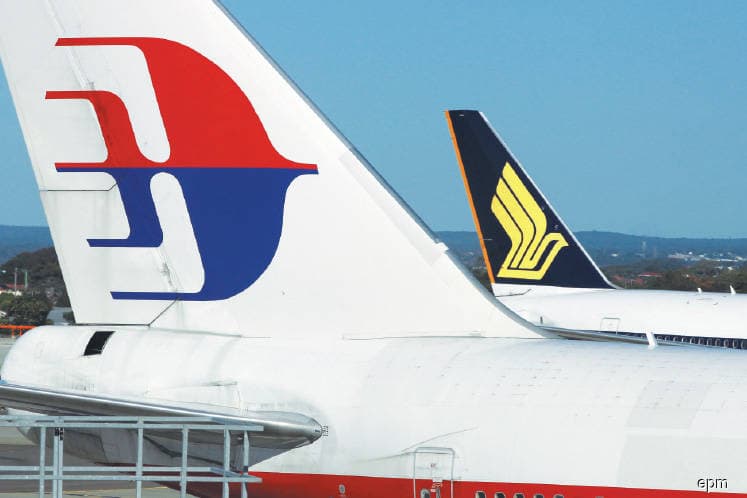
This article first appeared in The Edge Financial Daily on May 13, 2019
SINGAPORE: Given the challenging business environment and the downcycle of the aviation sector, Malaysia Airlines Bhd and Singapore Airlines Ltd (SIA) should be merged, according to Maybank Kim Eng Holdings Ltd regional aviation analyst Mohshin Aziz.
“[The solution is] very simple — merge. Forget the national identity crisis, and they can be merged. It will be able to remove a lot of costs and make themselves more efficient,” he said in a question-and-answer session at Invest Asia 2019 here last Friday.
Mohshin, who is also an associate director at Maybank Kim Eng Securities, pointed out that Malaysia-Singapore Airlines (MSA) was once the flag carrier of both countries before it broke up in 1972.
“If they were to merge, there will be a lot of improvements in terms of scheduling. Besides, relocation of assets can also be optimised,” he said.
“If the full-service carriers can get away from the mentality that ‘I am representing my country’, it will bring very good benefits to their business. That’s my firm view,” Mohshin stressed.
However, speaking to The Edge Financial Daily on the sidelines after his presentation, the aviation expert acknowledged that a merger between Malaysia Airlines and Singapore Airlines is easier said than done.
“If the governments dissociate themselves from the flag carriers, it can happen within a few months because [any] business-centric CEO (chief executive officer) [would] see this as a fantastic opportunity. That’s the only way to do it,” said Mohshin.
A notable example is the merger between KLM Royal Dutch Airlines and Air France, he said, as the national airline of the Netherlands and the French flag carrier derived “tremendous savings” within three years after merging.
“They amalgamated the system, they laid off people, they removed the overlaps, and they saved a lot of money. All these things were achieved within just three years,” Mohshin explained.
Air France took over the troubled KLM in 2004, but the two airlines continued to operate as separate entities with agreements in place to ensure that the Paris Charles de Gaulle and Amsterdam Schipol airports remain as important hubs for the group. The Dutch government’s concerns over the fate of Schipol and KLM prompted the Dutch government to increase its stake in the Air France-KLM holding company to 14% earlier this year, a move the French government described as “unfriendly”.
Another successful example is the merger between British Airways and Iberia which took place nine years ago, he said, as both airlines derived synergies even faster — within two years.
“We can see the benefit is very strong. We also saw the merger between Lufthansa and Air Berlin. They did that, and again, it has proven to be successful. It will take time, of course, but the horizon is very clear,” Mohshin said.
Lufthansa’s acquisition of Air Berlin was approved by the European Commission in December 2017 after anti-competition concerns were addressed.
Mohshin reiterated that if the airlines’ CEOs and boards of directors do not have the flag carrier status predicament, a merger is “definitely very practicable”.
“But obviously, now the problem is that every country wants to have its own national carrier. The governments are the so-called owners of Malaysia Airlines and Singapore Airlines, Thai Airways, Vietnam Airlines and Garuda Indonesia,” said Mohshin.
He went on to say that it was a wake-up call when Prime Minister Tun Dr Mahathir Mohamad said “I love Malaysia Airlines, but we can’t afford it”.
“When he was the prime minister for the first time, Malaysia Airlines had problems. Today, they still have problems. After so many years, there is no difference,” said Mohshin.
He further said that Malaysia Airlines has to think out of the box and change its entire business model.
“They can be merged; they could also team up or [enter into a] joint venture with some stronger airlines,” he suggested.
Geographically, said Mohshin, it also makes good sense for Malaysia Airlines and Singapore Airlines to be merged.
“Singapore and Malaysia are right there in Semenanjung [Peninsular Malaysia]. And we have a catchment area — Sabah and Sarawak. Both are very strong markets for Malaysia Airlines and Singapore Airlines. We could combine them, remove overlaps and make use of all the peak slots,” he said.
The outspoken analyst opined that the whole idea of having a flag carrier simply does not have any economic value and also does not make any economic sense.
“In fact, I think it is value-disrupting. By insisting that it is going to be a flag carrier, you are closing your door to the real opportunity out there,” Mohshin concluded.
Maybank Kim Eng has clarified that his views do not represent its position and house view.